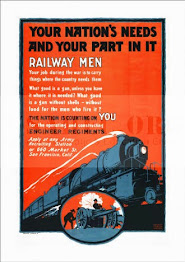727th Fort Eustis honors little-known WWII service
The infantry grabbed headlines in World War II. So did tank crews, pilots and sailors. But it took more than that to win the war.
Last week at Fort Eustis, the Army paid homage to two units that didn’t get a lot of attention, but whose members risked their lives to help win the war.
Meet the 727th Railway Operating Battalion and the Small Ships Section, both honored during the U.S. Army Transportation Conference held at Fort Eustis.
Representing the 727th at the conference was Allen Metzger, a native of Altoona, Pa. and an apprentice for the Pennsylvania Railroad when war broke out. He served throughout North Africa and Europe as one of 43,500 soldier railroaders.
Metzger was a machinist who inspected incoming locomotives, made out work orders on what needed fixing, got people to fix it and inspected the work afterwards. Sounds routine.
But railroaders didn’t have it easy in WWII. Germans were always looking to knock out supply lines, and he had to dodge strafing from an enemy fighter, potshots from a sniper and had one particularly nasty encounter with a bomb.
During a German bombing run, he was working in a pit underneath a locomotive when he felt the shock wave of a blast.
“It picked me up and threw me to the end of the pit, and hit me up against the wall,” he recalled. “In a pit, there’s a lot of water and grease and dirt. I was a mess.”
What happened then? He got cleaned up and went back to work.
“A bombing doesn’t last very long,” he joked.
The Small Ships Section was another little-known transportation service. It made its mark early in the Pacific Theater, when the Japanese were.
It started by conducting amphibious landings and supporting resupply and operational maneuvers during the New Guinea Campaign.
But here’s the thing: These “ships” were whatever was at hand. Motorboats. Tugboats. Sailboats.
Ernest Flint, a native of Australia, enlisted in the ship service when he was 17 years old. Today, he’s president of the U.S. Small Ships Association.
His first boat was a 40-foot wooden tug.
“I always had visions of walking up a gangway. I didn’t,” he said. “I climbed down a ladder.”
The ships ferried supplies to Allied troops and took out the wounded and the dead. During the day, they hid from Japanese aircraft, resting in small inlets and covering their boats with branches or other camouflage.
The inception of the Ship Service was traced to two brothers who had been part of two famous South Seas exploration expeditions in 1934 and 1940. It convinced them that small watercraft were needed for the war in the Pacific.
In December 1941, they recruited members from their own old crew for the duty. One member still survives: Philip Farley, a yachtsman from New York, who attended last week’s conference.
“For a year and a half, we were up and down the coast of New Guinea,” he said.
The civilian ships were armed with 50-caliber machine guns, but that was it. And if you served with Farley, you knew how to stay loose.
“I also was the one who made the best booze for everybody,” he joked.
http://weblogs.dailypress.com/news/local/military/blog/2010/07/fort_eustis_honors_littleknown.html
Last week at Fort Eustis, the Army paid homage to two units that didn’t get a lot of attention, but whose members risked their lives to help win the war.
Meet the 727th Railway Operating Battalion and the Small Ships Section, both honored during the U.S. Army Transportation Conference held at Fort Eustis.
Representing the 727th at the conference was Allen Metzger, a native of Altoona, Pa. and an apprentice for the Pennsylvania Railroad when war broke out. He served throughout North Africa and Europe as one of 43,500 soldier railroaders.
Metzger was a machinist who inspected incoming locomotives, made out work orders on what needed fixing, got people to fix it and inspected the work afterwards. Sounds routine.
But railroaders didn’t have it easy in WWII. Germans were always looking to knock out supply lines, and he had to dodge strafing from an enemy fighter, potshots from a sniper and had one particularly nasty encounter with a bomb.
During a German bombing run, he was working in a pit underneath a locomotive when he felt the shock wave of a blast.
“It picked me up and threw me to the end of the pit, and hit me up against the wall,” he recalled. “In a pit, there’s a lot of water and grease and dirt. I was a mess.”
What happened then? He got cleaned up and went back to work.
“A bombing doesn’t last very long,” he joked.
The Small Ships Section was another little-known transportation service. It made its mark early in the Pacific Theater, when the Japanese were.
It started by conducting amphibious landings and supporting resupply and operational maneuvers during the New Guinea Campaign.
But here’s the thing: These “ships” were whatever was at hand. Motorboats. Tugboats. Sailboats.
Ernest Flint, a native of Australia, enlisted in the ship service when he was 17 years old. Today, he’s president of the U.S. Small Ships Association.
His first boat was a 40-foot wooden tug.
“I always had visions of walking up a gangway. I didn’t,” he said. “I climbed down a ladder.”
The ships ferried supplies to Allied troops and took out the wounded and the dead. During the day, they hid from Japanese aircraft, resting in small inlets and covering their boats with branches or other camouflage.
The inception of the Ship Service was traced to two brothers who had been part of two famous South Seas exploration expeditions in 1934 and 1940. It convinced them that small watercraft were needed for the war in the Pacific.
In December 1941, they recruited members from their own old crew for the duty. One member still survives: Philip Farley, a yachtsman from New York, who attended last week’s conference.
“For a year and a half, we were up and down the coast of New Guinea,” he said.
The civilian ships were armed with 50-caliber machine guns, but that was it. And if you served with Farley, you knew how to stay loose.
“I also was the one who made the best booze for everybody,” he joked.
http://weblogs.dailypress.com/news/local/military/blog/2010/07/fort_eustis_honors_littleknown.html
Thursday, July 29, 2010
|
Labels:
727th Railway Operating Battalion
|
This entry was posted on Thursday, July 29, 2010
and is filed under
727th Railway Operating Battalion
.
You can follow any responses to this entry through
the RSS 2.0 feed.
You can leave a response,
or trackback from your own site.
Subscribe to:
Post Comments (Atom)







0 comments:
Post a Comment